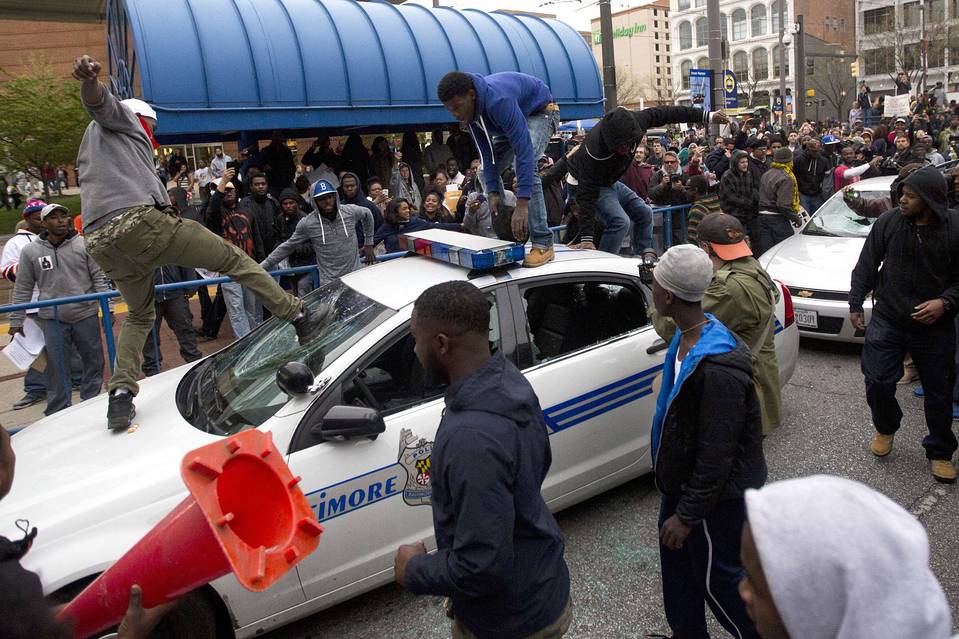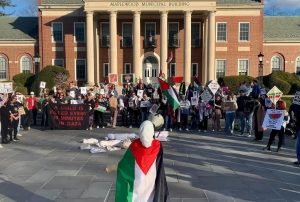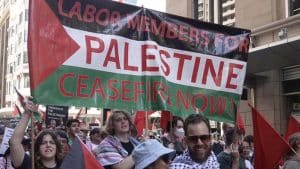This article is featured in our first printed issue, “A New Generation Rises up.” You can order your copy here.
Post-Racial Myth, Dispelled
The myth that US society had overcome racial divisions and inequality was shattered by people’s response to the repeated murders of Black people by police. Protests led by Black youth, women, and LGBT people successfully shut down highways, malls, and bridges. Die-ins took place on university campuses around the country.
Through disruptive tactics, BLM activists challenged Bernie Sanders on his platform, which left much to be desired when it came to the concerns of people of color. All the major presidential candidates were asked about Black Lives Matter and police brutality. The Democratic Party candidates were created platforms regarding anti-Black racism. Platforms that only existed because of the BLM disruptions.
The notion of a colorblind America is being replaced by a heightened awareness of police killings and attacks on Black people. However, the murder of Black people by police has not ceased. In 2015 alone, 1,134 people were murdered by police. The outcry and organization against police violence exposes the lie of a post-racial society. The Black Lives Matter movement laid bare the systemic nature of racism.
A Disjointed City
Within a nationwide context of racial oppression, the city of Baltimore is a striking example of segregation and poverty. Since 1910, when local officials passed a bill restricting Blacks to certain blocks with the aim of “reducing civil disturbance and preventing the spread of diseases,” numerous policies have maintained spatial segregation. Over time, formal racial segregation became less permissible and was replaced by insidious redlining practices that denied Blacks access to insurance, loans, and mortgages.
In addition to police brutality, a confluence of social and economic problems affect Baltimore’s Black population. Public schools in poor areas are grossly under-resourced and constantly threatened with privatization and closures, as school systems are largely funded through local property taxes. Joblessness is highest among Blacks: 37 percent of young Black men are unemployed compared to 10 percent of young white men. Because of the targeted imprisonment of Black people, about a third of Black people have criminal records, which employers check before hiring, making it even more difficult for them to get jobs. This makes it extremely difficult to break out of the vicious cycle of joblessness, poverty, illegal activities, and prison.
In poor Black neighborhoods, police employ violence with impunity. Their actions are protected and perpetuated by the legal system. Only 11 of the 65 officers charged in fatal shootings over the past decade were convicted.
Baltimore’s Rebellion
After Freddie Gray was murdered on April 19, 2015, the first stirrings of resistance sprang up in his neighborhood. Initially, protesters were almost entirely Black youth, children, and some elders from the surrounding neighborhood. After several days, the mobilizations spread throughout the city with massive participation by students, community activists, labor unions, faith-based groups, and left political organizations. People traveled from New York, Charlottesville, Philadelphia and Ferguson, where Black communities were waging similar struggles against police brutality.
The protests captured national headlines and the target of people’s rage became directed more and more toward city government leaders. The main demand was for officials to lock up and charge the officers who murdered Gray.
After an enormous rally at city hall, protesters broke away and swept through Inner Harbor, an upscale commercial district in downtown Baltimore. Seething with rage, hundreds ended up outside of Orioles’ Stadium. Two police vehicles were trashed before protesters were intercepted by heavily armed riot police. A few days later, dozens of Black high school students engaged in open confrontation with Baltimore police—throwing stones and exchanging blows. In a press conference that evening, Mayor Rawlings-Blake, a Black woman who commanded the nearly 50 percent Black Baltimore Police force, condemned the youth, labelled them thugs and pronounced the city under a state of emergency. In addition to deploying three thousand police officers from the Baltimore PD, Rawlings-Black called in reinforcement from the State Troopers and National Guard. In the days that followed, the state cracked down ruthlessly on protesters, locking up more than 480 demonstrators. The show of force and baseless arrests were aimed at debilitating the movement. Undeterred, about four thousand students from high schools and universities throughout Maryland marched through the city a few days later.
On May 1, State Prosecutor Mosby announced the decision to file criminal charges against the six police officers involved in Freddie Gray’s death. That same day marked the height of the mobilizations; an estimated ten thousand people took to the streets and circled the city twice over, chanting, “If we don’t get no justice, then you won’t get no peace!”
A Necessary Balance Sheet
The indictment—a significant departure from the system’s sanction of police murder—was a direct result of the mobilizations. The boldest actions were highly spontaneous, but without these confrontations, the news of Freddie Gray’s murder would not have entered the world’s purview. At the same time, these isolated, unorganized acts of rage alone would not have drawn the same awareness and ultimate results. If not for the widespread support of workers, students, labor unions and community organizations, the state could simply have extinguished the protests through repression and refused to offer any concessions.
After May 1, mobilizations quickly waned. Black religious leaders and reformist political parties cheered the results and hastened to bring the raw street resistance to an end. Ministers, the New Black Panther Party and other self-appointed Black community leaders held celebratory closing rallies in front of city hall, while one hundred people were still locked up in central booking a few miles away. A small minority continued to fight and demanded that the detainees be released and their charges dropped. However, the majority of organizations failed to mount a united response.
The Lack of Coordination in a United Front
Overall, the widespread mobilizations assembled loose groupings of activists, left political parties, labor organizations, community groups and students whose combined response brought ten thousand people to the streets, resulting in the indictment of Freddie Gray’s killers.
However, the movement never achieved any real coordination between the various sectors involved in the protests. Actions were highly fragmented and undirected. Multiple groups refused to march together and instead called for separate, competing rallies, splitting the potential force of the mobilizations. Some community leaders dismissed out-of-towners and labeled them “outsiders” rather than embracing them in a common struggle against police brutality.
The lack of coordination and unwillingness to call for a workers’ united front turned out to be detrimental to the uprising’s political potential, which was all too quickly subdued by the state’s nominal concessions. Such a front would have been a step towards uniting workers of various sectors to fight against police brutality. These are not merely organizational or tactical issues. The rejection of the united front tactic against state repression and racism belies a strategic revolutionary perspective.
While few and far between, there have been key examples of organized labor taking a stand against police brutality. On May Day, 2015, ILWU Local 10 shutdown the Port of Oakland in protest of police terror. Unite Here Local 7 mobilized its members for several days of protest following Freddie Gray’s death. Later that summer, University of California graduate students and faculty of United Auto Workers (UAW) Local 2865 passed a resolution calling on the AFL-CIO to end its affiliation with the International Union of Police Associations. Local 2865’s resolution stated that police unionization “allows police to masquerade as members of the working-class and obfuscates their role in enforcing racism, capitalism, colonialism, [and] oppression.” These are all methods for workers to take up the fight against police brutality at their workplaces.
All workers should push their unions to not only call for the expulsion of the police, but act in concert and in solidarity with oppressed communities: in this case, with Black youth in resistance against police brutality. Beyond any single tactic or gesture, it is fundamental for labor unions and working-class people to organize against racism and for an end to Black and brown oppression.
A Fledgling Movement at an Impasse
BLM is the most dynamic political movement in the US today. Organizing women, youth and LGBT people have taken on the police and capitalist politicians and called for an end to systematic racism. The BLM movement has forced the hand of a few bourgeois politicians. Presidential rally disruptions, freeway shutdowns, occupations, and bridge takeovers have influenced the policies of local police; prosecutors uncharacteristically indicted cops; commissioners and elected officials have stepped down; the Department of Justice has opened up (useless but highly publicized) investigations. BLM has brought international attention to the mass incarceration of people of color.
Highly spontaneous and politically heterogeneous, the movement has demonstrated the propensity to fall to the pressures of two overlapping ideologies: Black nationalism and reformism.
BLM is a decentralized network, with chapters that are autonomous in character and action. Around the country, some political disagreements are being articulated. Some minority sectors have claimed the organization is being “co-opted” but no such grouping has successfully advanced a program delineating these political differences or proposing a strong alternative.
Predominant tendencies within Black nationalism are no longer tied to the idea of secession or territory, but are certainly tied to the socio-cultural “secession” of Black people. Black nationalism is expressed through the call for Black leadership, for an end to white supremacy, for greater equality and access to schools and against police brutality. Despite the militant history of Black people under the banner of Black Nationalism, most famously the Black Panthers, the development of these tendencies has led to a cross-class collaborationist response to anti-Black racism. This perspective fails to provide a critique of the “Black elite,” who have reached positions of (political or economic) power; in fact, some Black nationalists celebrate this elite.
Reformism, which often expresses itself in different forms of nationalism, has found ample expression in the Black Lives Matter movement. It is led by trust in capitalist institutions and the belief in a smooth transition to a “free society”; it feeds the illusion that gradual reforms will achieve a free and democratic society.
A cohort of Black activists is paving the way for institutionalization, heading straight for one of the major “trenches” of American capitalism—in Gramscian terms—the nonprofit sector. A tendency towards incorporation, social entrepreneurship and professional activism pervades the BLM National leadership. Furthermore, many BLM leaders have pleaded for presidential candidates to address race issues. While presenting a subversive or radical appearance, in practice, these prominent activists seek to move bourgeois politicians to the left—or even become those politicians. Prominent BLM activist DeRay McKesson ran for Baltimore City mayor in April 2016. He won three percent of the vote and came in sixth place. It was the first time that a well-known figure of the BLM movement ran for elected office. McKesson’s campaign actually represented the right wing of the heterogeneous movement. A week before he announced his plans to run, he met with Obama.
Reform the Police or Destroy the System
Some activists promote the installation of Black (or “Black-friendly”) bourgeois politicians. They issue recommendations for body cameras, cultural sensitivity trainings, and “community control” and organize copwatch against police violence. These are all damaging in the long run because they channel the anti-systemic rage of the people through institutional and reformist channels, fomenting trust in the master’s tools and the vile bourgeois legal system.
Since professionalized policing first emerged in the 1820s, its primary role has been to control the “dangerous classes”: to break up labor strikes and work stoppages, arrest social and political “deviants,” etc. Radicals, Blacks, immigrants, LGBT people, the poor, the homeless, and people with disabilities are constant targets. The capitalist state has an unmistakable monopoly on the “legitimate” use of force. The police and their murderous, debasing methods are designed to protect the private property of the owning class; they exist to protect the status quo. The same goes for detention and corrections officers, as well as border patrol.
How then can the community “control” cops without exterminating their masters, the capitalist class, and controlling society? How can the community control the police without destroying the current capitalist state?
Capitalist regimes utilize and foment racism to divide workers and enable the super-exploitation of certain sectors. How do we end racism, driven by capitalism, if we do not organize resistance against capitalism and the bourgeoisie, along with its political parties?
Reformism flies in the face of reality. The capitalist class will never hand over power and the material basis of production to the working and oppressed for the sake of progress, democracy, the betterment of our conditions.
Cops are enemies of the working class. Even as Black men and women are being shot dead in cold blood by cops, even after the US has undergone a radicalization and massive uprising of people against racist policing and brutality, some “progressives” and even socialist organizations cling to the incorrect notion that police collectively form a part of the working class.
Some argue that police may one day shed their roles as strikebreakers, repressors, and racist murderers, and instead join their working-class brothers and sisters to fight against their capitalist masters. In a revolutionary situation, when class struggle has taken the form of civil war, and mutual attacks are open and unfettered, it is possible that a few individual police officers may resign from their posts and take the side of the working class. However, the police, as a category, will be on the side of the capitalists, as they have always been. When postulated outside of a revolutionary context, however, the idea of the police fighting on the side of the working class is an entirely fantastical notion.
The Stalinist Workers World Party’s central demand for community control of the police reveals the organization’s utterly reformist character. Similarly, Socialist Alternative’s push for unionization of the police force is totally mistaken. Police unions have only been shown to push for reactionary politics, officers’ impunity and discretionary use of force.
Challenges and the Role of the Left
Black workers—along with immigrant workers—make up some of the most exploited layers of the U.S. working class. Due to the fact that they’re subjected to the double burden of racism and capitalist exploitation, they have a potential energy to fight longer, harder, and with more resolve. Thus, Black and minority workers are an indispensable component of any left organization with serious revolutionary aspirations.
The left can win the confidence of youth, people of color, workers, and activists by fighting shoulder-to-shoulder on the streets and offering a revolutionary program to end police brutality. One progressive step in building a revolutionary party would be the formation of a workers’ united front that could effectively fight against police brutality.
This article is featured in Left Voice Magazine, which you can purchase by clicking here.













